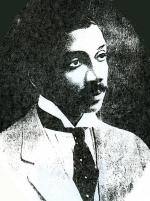![header=[Marker Text] body=[Owned by Black entrepreneur John T. Gibson, this theater featured noted Black American entertainers of the 1920s including Duke Ellington and Ethel Waters. The theater attracted multi-racial audiences until it closed in 1931. ] sign](kora/files/1/10/1-A-62-139-ExplorePAHistory-a0a5b3-a_450.gif)
Mouse over for marker text
Name:
Standard Theatre
Region:
Philadelphia and its Countryside/Lehigh Valley
County:
Philadelphia
Marker Location:
12th & South Street, Philadelphia
Behind the Marker
In 1927, Duke Ellington and his band, the Washingtonians, were playing an extended gig at the Standard Theatre in Philadelphia. When Owney Madden decided he wanted Ellington back at his Cotton Club in New York City, he made a call to Philadelphia bootlegger Maxie "Boo Boo" Hoff, who in turn sent Yankee Schwartz to speak to the Standard's manager. There, Schwartz made his offer. "Be big. Or you'll be dead." The next day, Ellington and his band were on the train back to New York.
Such were the obstacles that black theater owners faced in the Roaring Twenties. John T. Gibson, a native of Baltimore, ran Gibson's Auditorium Theatre on South Street and made good money booking African-American vaudeville, musical black acts on the national "chitlin circuit."
In 1914, Gibson bought the Standard Theatre on the 1100 block of South Street. His timing couldn't have been better, for in the following years, tens of thousands of southern blacks would pour into the city of Philadelphia as part of the Great Migration unleashed by the First World War.
Young men and women, with good jobs and money in their pockets, flocked to Gibson's Standard Theatre to see a fare of "High Class and Meritorious Vaudeville," stage shows, and popular music. The Standard became a regular stop for Black performers on their national tours: comedians Bylow and Ashes, singers Bessie Smith and Ethel Waters, Erma C. Miller's Brown Skinned Models, popularly known as the "Black Rockettes," and jazz bands led by Louis Armstrong and Duke Ellington.
In 1921, Gibson bought the failing Dunbar Theater, which had been constructed by black bankers E. C. White and Andrew Stevens just a few years earlier, for an estimated $600,000. Ticket sales at the Standard and Dunbar made Gibson the richest black man in Philadelphia. He bought an estate in the suburb of Whitemarsh, kept a house in West Philadelphia, and rode around in a red Pierce Arrow driven by a white chauffeur. In the 1920s the Standard was the anchor of a thriving African American entertainment district that appealed to both blacks and whites.
Dunbar Theater, which had been constructed by black bankers E. C. White and Andrew Stevens just a few years earlier, for an estimated $600,000. Ticket sales at the Standard and Dunbar made Gibson the richest black man in Philadelphia. He bought an estate in the suburb of Whitemarsh, kept a house in West Philadelphia, and rode around in a red Pierce Arrow driven by a white chauffeur. In the 1920s the Standard was the anchor of a thriving African American entertainment district that appealed to both blacks and whites.
Black and Tan clubs, as they were called, drew white music lovers to clubs that featured black staff and performers and helped spread the popularity of jazz in Philadelphia. As their popularity grew, many of the major jazz acts that came to town played the whites-only theaters and clubs in Center City first, which drew off audiences that would otherwise have traveled to the clubs of South and North Philadelphia. Throughout the 1920s, however, the Standard was a showplace for black music in Philadelphia, and a place where the Nicholas Brothers, Ethel Waters, and other homegrown talents were able to get their start.
During the Great Depression, Gibson, who had been heavily invested in real estate, lost both of his theaters, which became movie houses. The Standard, which opened in 1888, closed in 1954 and was torn down in 1957.
Such were the obstacles that black theater owners faced in the Roaring Twenties. John T. Gibson, a native of Baltimore, ran Gibson's Auditorium Theatre on South Street and made good money booking African-American vaudeville, musical black acts on the national "chitlin circuit."
In 1914, Gibson bought the Standard Theatre on the 1100 block of South Street. His timing couldn't have been better, for in the following years, tens of thousands of southern blacks would pour into the city of Philadelphia as part of the Great Migration unleashed by the First World War.
Young men and women, with good jobs and money in their pockets, flocked to Gibson's Standard Theatre to see a fare of "High Class and Meritorious Vaudeville," stage shows, and popular music. The Standard became a regular stop for Black performers on their national tours: comedians Bylow and Ashes, singers Bessie Smith and Ethel Waters, Erma C. Miller's Brown Skinned Models, popularly known as the "Black Rockettes," and jazz bands led by Louis Armstrong and Duke Ellington.
In 1921, Gibson bought the failing
Black and Tan clubs, as they were called, drew white music lovers to clubs that featured black staff and performers and helped spread the popularity of jazz in Philadelphia. As their popularity grew, many of the major jazz acts that came to town played the whites-only theaters and clubs in Center City first, which drew off audiences that would otherwise have traveled to the clubs of South and North Philadelphia. Throughout the 1920s, however, the Standard was a showplace for black music in Philadelphia, and a place where the Nicholas Brothers, Ethel Waters, and other homegrown talents were able to get their start.
During the Great Depression, Gibson, who had been heavily invested in real estate, lost both of his theaters, which became movie houses. The Standard, which opened in 1888, closed in 1954 and was torn down in 1957.
Beyond the Marker







